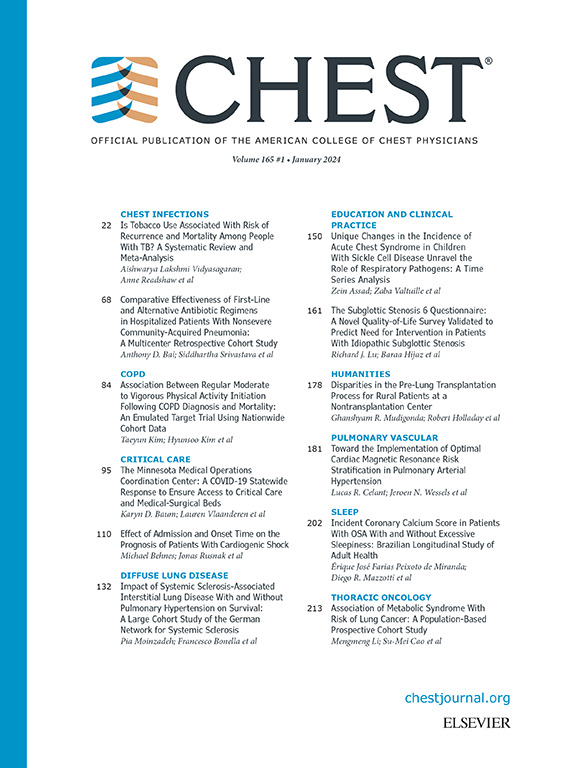Association between airway mucus plugs and risk of moderate-to-severe exacerbations in COPD patients:results from a Chinese prospective cohort study.
IF 9.5
1区 医学
Q1 CRITICAL CARE MEDICINE
引用次数: 0
Abstract
BACKGROUND Airway mucus plugs are frequently identified on computed tomography (CT) scans of patients with chronic obstructive pulmonary disease (COPD) and are associated with worse airflow obstruction and higher mortality. However, the association between airway mucus plugs and the risk of acute exacerbation of COPD (AECOPD) has not been extensively studied. RESEARCH QUESTION Are airway mucus plugs associated with the risk of future moderate-to-severe AECOPD? STUDY DESIGN AND METHODS In this prospective cohort study, we identified airway mucus plugs on CT scans of COPD patients. Mucus plugs were scored from 0 to 18 based on the number of pulmonary segments affected and categorized into three groups (0, 1-3, and ≥4). Patients were followed for two years. Negative binomial regression and Cox regression were used to model the association between airway mucus plugs and moderate-to-severe AECOPD, adjusting for potential confounders. RESULTS Among the 194 COPD patients, 22%, 35%, and 43% had mucus plugs in 0, 1-3, and ≥4 pulmonary segments, respectively. During the following year, 30% of patients experienced at least one moderate-to-severe AECOPD, with the incidence 12%, 25%, and 44% for patients with 0, 1-3, and ≥4 pulmonary segments with mucus plugs, respectively. In negative binomial regression, each 1-point increase in airway mucus plug score was associated with an 8.3% higher risk of moderate-to-severe exacerbations(RR[95% CI], 1.08[1.01-1.16], p=0.028). In multivariate Cox regression, mucus plugs in ≥4 versus 0 and ≥4 versus 1-3 pulmonary segments were associated with hazard ratios of moderate-to-severe exacerbation of 5.02(95% CI, 1.84-13.75, p=0.002) and 2.32(95% CI, 1.25-4.33, p=0.008), respectively. Consistent results were observed in the subset of patients completing the two-year follow-up (n=150). INTERPRETATION In COPD patients, airway mucus plugs are associated with increased future risk of subsequent moderate-to-severe AECOPD. TRIAL REGISTRATION Registered with the International Clinical Trials Registry (NCT03240315, 2017-07-3).慢性阻塞性肺病患者气道粘液栓与中重度病情加重风险之间的关系:一项中国前瞻性队列研究的结果。
背景:在慢性阻塞性肺疾病(COPD)患者的计算机断层扫描(CT)中经常发现气道粘液塞,并与更严重的气流阻塞和更高的死亡率相关。然而,气道粘液塞与慢性阻塞性肺病(AECOPD)急性加重风险之间的关系尚未得到广泛研究。研究问题:气道粘液塞是否与未来发生中重度AECOPD的风险相关?研究设计和方法在这项前瞻性队列研究中,我们在COPD患者的CT扫描中发现气道粘液塞。根据受影响肺段的数量对粘液塞进行0 - 18分,并分为3组(0、1-3和≥4)。患者被随访了两年。采用负二项回归和Cox回归对气道粘液塞与中重度AECOPD之间的关系进行建模,并对潜在的混杂因素进行校正。结果194例COPD患者中,分别有22%、35%和43%的患者在0、1-3和≥4个肺段存在粘液塞。在接下来的一年中,30%的患者至少经历了一次中重度AECOPD,其中0、1-3和≥4肺段粘液塞患者的发病率分别为12%、25%和44%。在负二项回归中,气道粘液堵塞评分每增加1分,中重度加重的风险增加8.3% (RR[95% CI], 1.08[1.01-1.16], p=0.028)。在多变量Cox回归中,≥4个肺段与0个肺段、≥4个肺段与1-3个肺段的黏液塞与中度至重度加重的风险比分别为5.02(95% CI, 1.84-13.75, p=0.002)和2.32(95% CI, 1.25-4.33, p=0.008)。在完成两年随访的患者亚组(n=150)中观察到一致的结果。在COPD患者中,气道粘液塞与随后发生中度至重度AECOPD的未来风险增加相关。在国际临床试验注册中心注册(NCT03240315, 2017-07-3)。
本文章由计算机程序翻译,如有差异,请以英文原文为准。
求助全文
约1分钟内获得全文
求助全文
来源期刊

Chest
医学-呼吸系统
CiteScore
13.70
自引率
3.10%
发文量
3369
审稿时长
15 days
期刊介绍:
At CHEST, our mission is to revolutionize patient care through the collaboration of multidisciplinary clinicians in the fields of pulmonary, critical care, and sleep medicine. We achieve this by publishing cutting-edge clinical research that addresses current challenges and brings forth future advancements. To enhance understanding in a rapidly evolving field, CHEST also features review articles, commentaries, and facilitates discussions on emerging controversies. We place great emphasis on scientific rigor, employing a rigorous peer review process, and ensuring all accepted content is published online within two weeks.
 求助内容:
求助内容: 应助结果提醒方式:
应助结果提醒方式:


